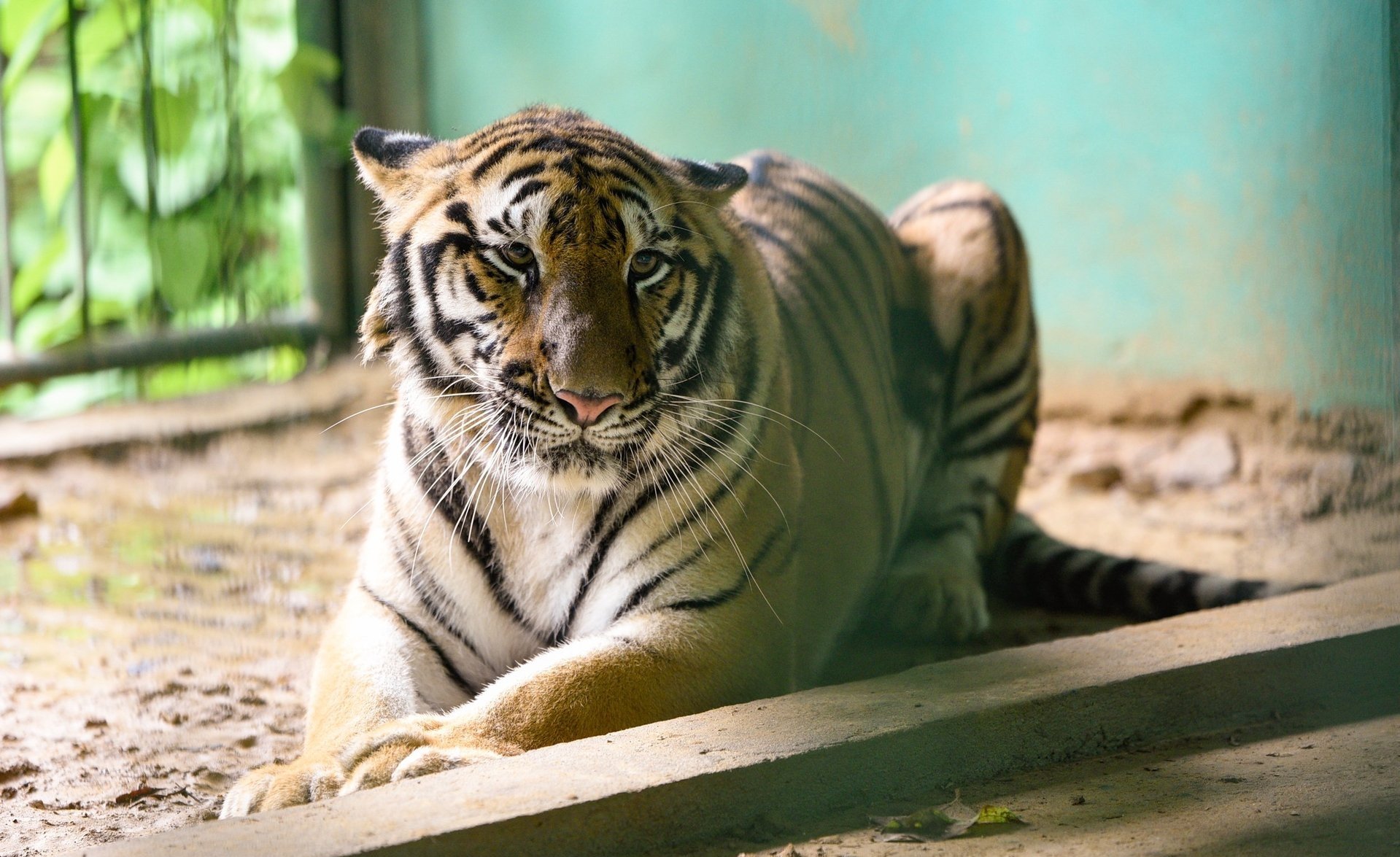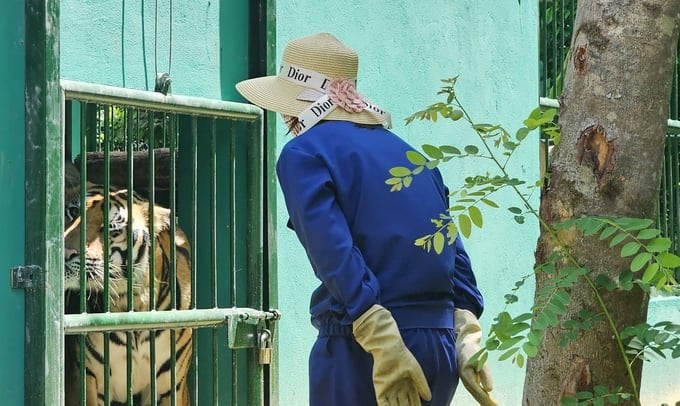May 28, 2025 | 11:04 GMT +7
May 28, 2025 | 11:04 GMT +7
Hotline: 0913.378.918
May 28, 2025 | 11:04 GMT +7
Hotline: 0913.378.918

Indochinese tigers are smaller in size than Bengal tigers and Siberian tigers. Photo: Tung Dinh.
Indochinese tigers are found in Cambodia, Laos, Myanmar, Thailand and Vietnam. Compared to other subspecies, such as the Bengal tiger and Siberian tiger, the size of the Indochinese tiger is smaller, and the fur has a darker background color with shorter and narrower single stripes.
Adult males are about 2.55 - 2.85m long and weigh about 150-195kg. In particular, some individuals can weigh up to 250kg. Females are smaller, averaging about 2.44m long and weighing about 115kg.
After about 3-4 months, the female Indochinese Tiger will give birth to cubs, a litter of about five cubs. Newborn Indochinese tigers weigh about 1 kg and will breastfeed for the first 18 months. After that, they switched to eating meat. By 18 months, tiger cubs begin to hunt on their own.
Indochinese tigers can live in forests, grasslands, mountains and hills. However, they prefer most forest habitats, such as tropical rainforests, evergreen forests, deciduous forests, and subtropical and tropical dry broadleaf forests.
From the 1960s onwards, Indochinese tigers appeared throughout the mountainous areas of Vietnam, even the midlands and islands. However, their distribution is currently narrow; most are kept in captivity in conservation areas.
Indochinese tigers live solitary lives in deep forests and mountainous terrain, most located along the borders between countries. Access to these areas is often restricted, and few biologists are allowed in for field research. For this reason, relatively little is known about this tiger subspecies' condition, habits, and behavior in the wild.
In particular, in the past 20 years, Indochinese tigers have no longer been seen in the wild in Vietnam. All people know about them is through the footprints left behind.

Adult male Indochinese tigers can weigh up to 250kg. Photo: Tung Dinh.
Phong Nha-Ke Bang National Park is one of the few parks carrying out Indochinese tigers' conservation work. Due to its rich ecosystem and the largest area among the 34 national parks (more than 123,000 hectares), the park cares for seven tiger individuals.
Since 6 a.m., Mr. Cao Quy Ha, an employee of the Center for Animal Conservation and Development, has been preparing for a new day. After taking about 30kg of food for seven individual tigers, he cleaned the cage and remembered going to barn No. 1, where the alpha male tiger, Do, is kept.
Do is one of the tiger individuals Pu Mat National Park handed over in 2022. After more than a year of care, Do now weighs 150kg.
"The tiger care process here is rigorous. In the morning, two staff members usually come and observe. First, check whether the door lock and hooks are safe, and also see which cage the tigers are in. After that, I went directly into the barn," Mr. Ha said.
During his daily work, Mr. Ha admitted that he needed the cooperation of these tigers. Therefore, care staff must have genuine affection for the tiger for this animal to cooperate.
The care and nurturing area for Indochinese tigers at Phong Nha-Ke Bang National Park is nearly 3,500m2, with a full range of construction items to meet better care and enabling conditions, helping individual tigers grow and develop well.
In particular, the staff here all talk to the tigers like family and call the tiger "brother" and "friend." They take care of the tigers in terms of nutrition and try to give them behavior like in the wild.
Ms. Phung Thu Cuc, an Animal Asia Foundation employee, said: "When working with tigers, we try to bring the most positive experience for the tigers. For example, when the tiger is in a small cage, we try to keep the tiger's stress as low as possible, especially when feeding and drinking water."
According to Ms. Cuc, if they clean the cage in the first months, they do it gently to help the tiger reduce stress. In particular, care staff do not use high-pressure sprays so that the tiger feels most comfortable.
After that, when the tiger gets used to it and is less stressed, Ms. Cuc and her colleagues will use other measures to clean the cage and ensure a better environment for the tiger.
In the coming time, Phong Nha-Ke Bang National Park is researching bringing seven individual tigers to be raised in a semi-wild area.
Although there are many different views on ex-situ conservation, park staff believe it is necessary to focus on dedicating the best resources to conserve and store genetic resources for animal species listed in the red book, including the Indochinese tiger.
Translated by Huong Giang
/2025/05/25/4127-3-073637_820.jpg)
(VAN) Thanks to the promotion from an FAO-implemented project, vegetable production in greenhouses in Moc Chau has seen strong development, from 1.5 hectares in 2021 to nearly 50 hectares in 2024.

(VAN) FAO has recently supported USD 140,000 to implement the project 'Risk mitigation human-animal interface risks through disease control initiatives in pig farming.'

(VAN) The People's Committee of Tra Vinh province has approved an adjustment to the investment policy for the Green Hydrogen Plant project, increasing its area to approximately 52.76 hectares.
![Reducing emissions from rice fields: [2] Farmers’ commitment to the soil](https://t.ex-cdn.com/nongnghiepmoitruong.vn/608w/files/news/2025/05/05/dsc08881jpg-nongnghiep-140632.jpg)
(VAN) Clean rice cultivation model in Thuong Tan commune, Bac Tan Uyen district, is assisting local residents in achieving sustainable agriculture by substantially reducing costs, increasing productivity, and protecting the environment.

(VAN) At the conference to disseminate Resolution No. 68, AgriS introduced its digital agricultural ecosystem and reaffirmed its commitment to accompanying the Government in promoting private sector development and sustainable agriculture.

(VAN) 'Blue Ocean - Blue Foods' initiative is designed to restore marine ecosystems and establish sustainable livelihoods for local communities by cultivating a minimum of 1,000 hectares of cottonii seaweed in the first three years.
/2025/05/21/4642-3-112707_603.jpg)
(VAN) The V-SCOPE project has made direct contributions to three out of six pillars of the Comprehensive Strategic Partnership between Vietnam and Australia.